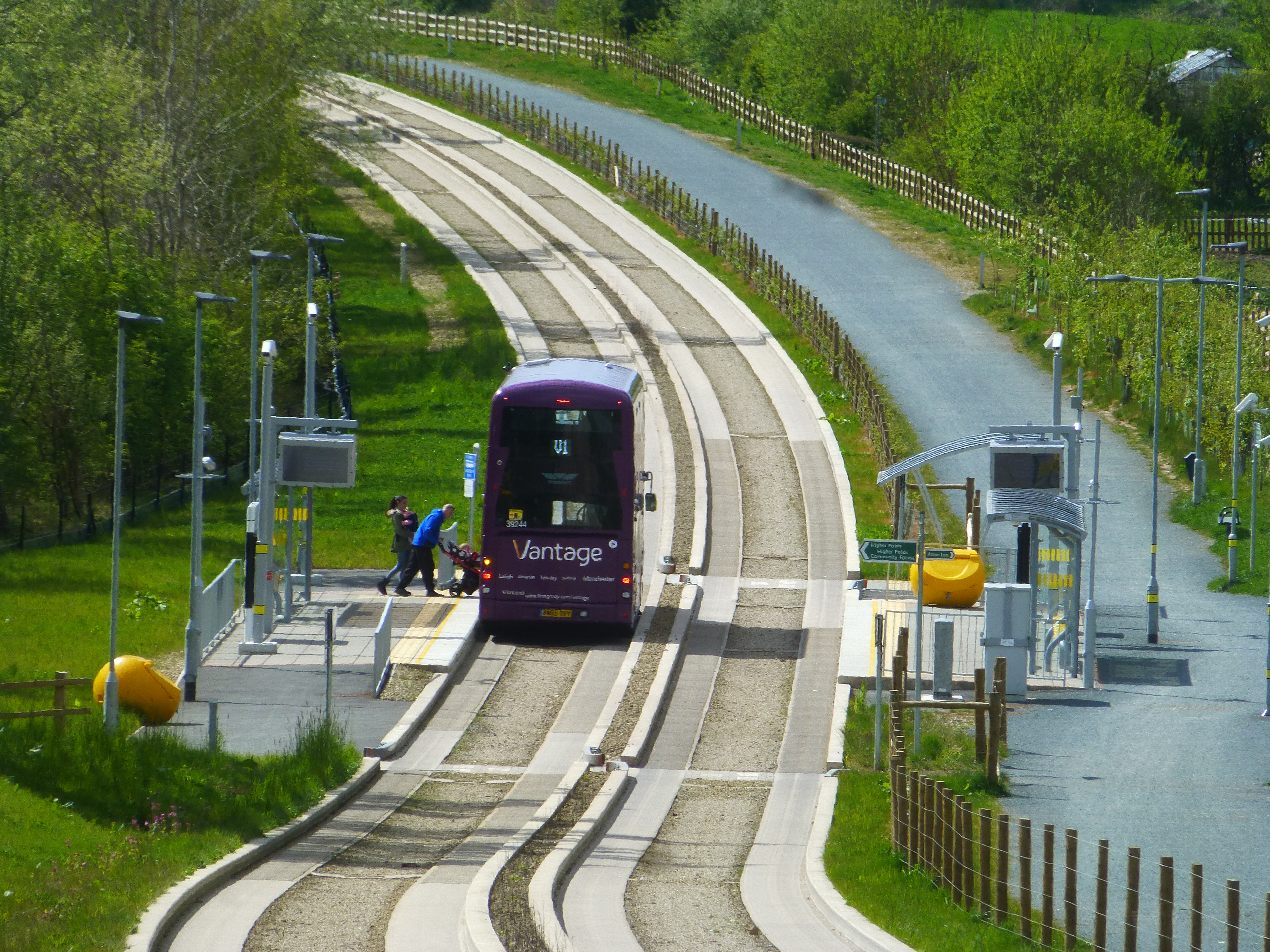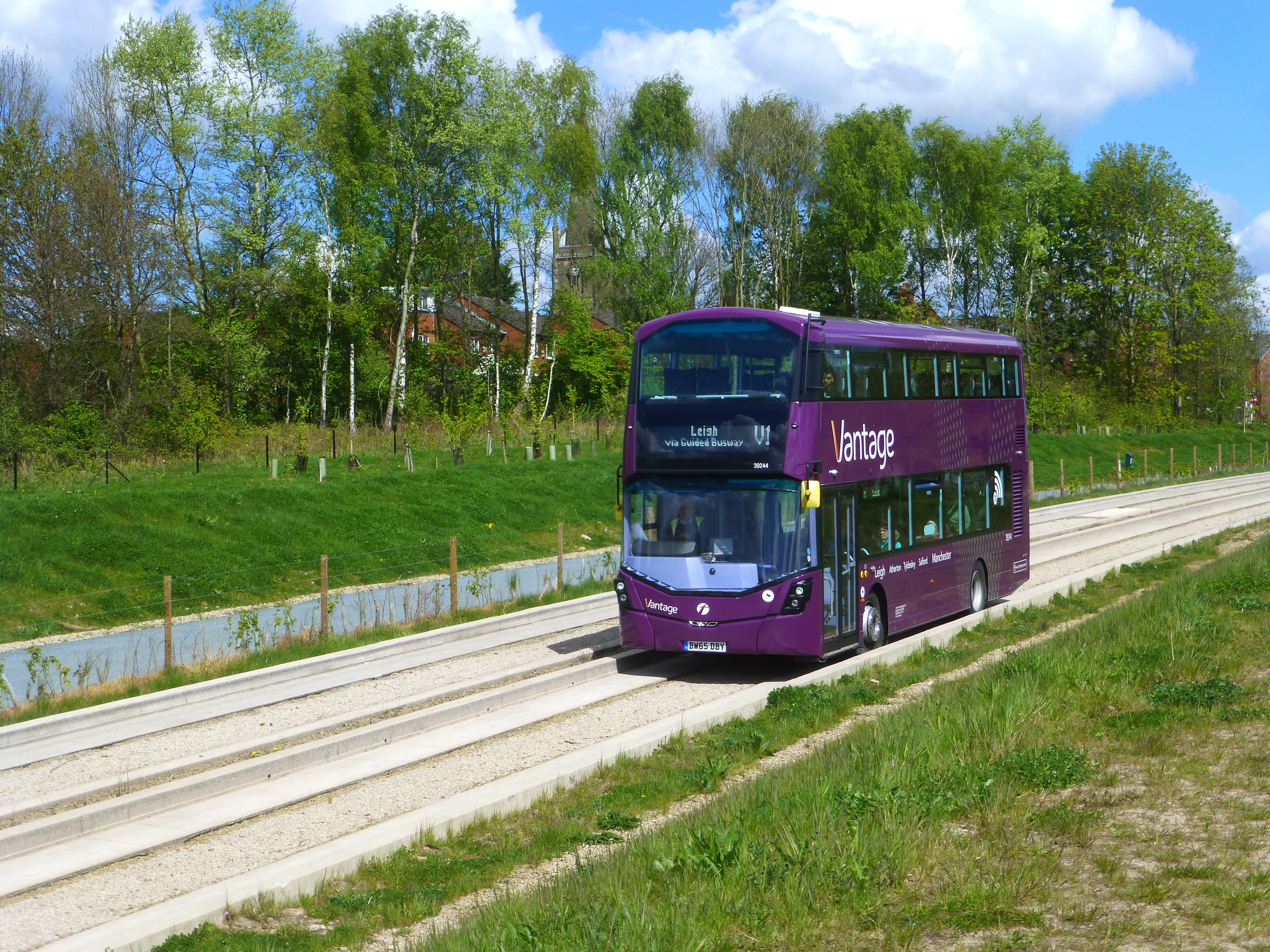
Wikimedia Commons
The Leigh-Ellenbrook guided busway is part of the Leigh-Salford-Manchester bus rapid transit scheme in Greater Manchester, England. The guided busway provides transport connections between Leigh, TyldesleyFormer industrial town in the Metropolitan Borough of Wigan, in Greater Manchester. and Ellenbrook and onwards to Manchester city centre on local roads. The bus rapid transit scheme promoted by Transport for Greater Manchester (TfGM) opened on 3 April 2016. Built by Balfour Beatty at a cost of £68 million, to improve links from former coalfield towns into Manchester city centre, the busway proposal encountered much opposition and a public enquiry in 2002 before construction finally started in 2013. The bus route from Atherton and extension to the Manchester Royal Infirmary were added to the original scheme.
The service operates using purple-liveried Wright Eclipse Gemini 3 bodied Volvo B5LH hybrid double-decker buses equipped with CCTV and next stop audio and visual announcements. Stops on the guided busway have level-boarding from platforms equipped with passenger information display screens.
From Leigh, the V1 limited-stop bus service joins 7 kilometres (4 mi) of guided busway to Ellenbrook
Residential suburb of Worsley in the City of Salford in Greater Manchester, England., and then runs via bus lanes on the East Lancashire Road and through Salford and Manchester city centres. The V2 service from Atherton to Manchester joins the guided busway at Tyldesley; both services continue to Manchester Royal Infirmary.
Background
When proposed, the busway was controversial and encountered much local opposition.[1] Leigh, one of the largest towns in Britain without a railway station after the closure of the Tyldesley LooplineRailway line built in 1864 to connect local collieries to the Liverpool–Manchester main line. in 1969, suffered from poor transport connections to neighbouring towns. A guided busway scheme using a kerbed concrete track was proposed using the former railway trackbed from Leigh to Ellenbrook to improve access to Manchester city centre from Leigh, Tyldesley and Ellenbrook and regenerate areas of the former Lancashire CoalfieldThe Lancashire and Cheshire Coalfield in North West England was one of the most important British coalfields. Its coal seams were formed from the vegetation of tropical swampy forests in the Carboniferous period more than 300 million years ago.. A long legal process preceded the busway’s construction, including a public inquiry in 2002.[2] The decision of the public inquiry was delayed because great crested newts occupied a site on the route. The Department for Transport granted powers to build the busway in 2005 and it was projected to be built by 2009, but preliminary work only started in 2012.[3] Powers to build it are set out in the Greater Manchester (Leigh Busway) Order 2005 in the Transport and Works Act.[4] Greater Manchester Passenger Transport Authority had estimated that the busway would generate around 2 million passenger trips per annum.[3]
Kerb-guided busways are usually 6.7 metres wide with two, 2.6 metre wide bus lanes, a 0.8 metre central reservation and a 0.7 metre evacuation strip. At either end of the guided sections, standard buses with minor adaptations for the guided phase can transit to and from existing roads. Car traps and warning signs are placed to prevent other vehicles entering the guided section. The buses are guided by on-board cameras and computers controlling guidance motors attached to the steering column.[5]
Construction
Site clearance along the guided busway route between Leigh and Ellenbrook took place between November 2012 and March 2013. Balfour Beatty began construction in September 2013.[6] A short section of the busway west of Newearth Road was completed in early 2015 and in the April was used for a trial of the construction method and the bus guidance system.[7]
The busway was constructed by Extrudakerb using slipformed concrete rather than the precast concrete alternative used for the Cambridge and Luton guided busway projects. Slipforming was chosen for its lower start up costs and cost effectiveness.The technique is able to form any curve or superelevation and is not restricted by the limited range available for precast. Extrudakerb formed the busway as two 3 metre wide monoliths with upstand kerbs and drainage channel.[5]
Following delays caused by bad weather and other problems, the busway works were rescheduled to be completed before the end of 2015. The service began on 3 April 2016.[7] TfGM spent £122 million on bus priority investment of which the guided busway track and infrastructure cost £68 million and the rest was spent upgrading associated local roads, bus lanes and junctions. The Greater Manchester Transport Fund provided most of the funding and the Department for Transport contributed £32.5 million.[5]
Buses and stops
Services are operated by Wright Eclipse Gemini 3 bodied Volvo B5LH hybrid double-decker buses in purple-livery. They are equipped with CCTV, next-stop audio and visual announcements, USB charging points and free Wi-Fi.[7] Vehicles can operate at up 80 km/h on the busway.[5]
Seven stops along the guided busway provide level-boarding from platforms that are equipped with passenger information display screens. Queensway Shelters supplied the busway’s six-bay (9m long x 1.5m wide) cantilever shelters and cycle shelters. They were designed to incorporate the project’s requirements including toughened glass panels, seating, LED lighting, CCTV and speaker housings.[8] The guided busway crosses local roads on level, light-controlled junctions at which busway services have priority.
Route and operation
The Vantage bus route begins at Leigh bus station, and joins the guided section at East Bond Street. It proceeds through Leigh and along the converted rail alignment via Tyldesley to Newearth Road in Ellenbrook. An improved bus route from Atherton joins the route at Astley Street, Tyldesley. From Ellenbrook the route continues on to the A580 East Lancashire Road before joining the A6 at Irlams o’ th’ Height. It passes through Salford before continuing through Manchester city centre to Oxford Road and on to Manchester Central Hospitals.
The guided section has stops at East Bond Street and Holden Road in Leigh and Cooling Lane between Higher Folds and Squires Lane in Tyldesley, Astley Street, Hough Lane and Sale Lane in Tyldesley and Newearth Road in Ellenbrook. The multi-user path for walkers, horse riders and cyclists alongside the guided section provides access for emergency vehicles and maintenance.[9]For cyclists the path from Tyldesley to Ellenbrook is part of the National Cycle Network Route 55.[10]
First Greater Manchester runs the Vantage service.[11] In the first six months of operation, more than 900,000 passenger journeys were made. A survey of users published in October 2016 revealed that 20 per cent of passengers had switched from using their cars for the same journey. More than a quarter of busway users walked or travelled more than a kilometre to reach the busway.[12][13] By December 2017, weekly ridership had increased to 62,000. More than 7.8 million journeys were made on the guided busway in the three years after opening and three million of them were made in the year to April 2019.[14]


